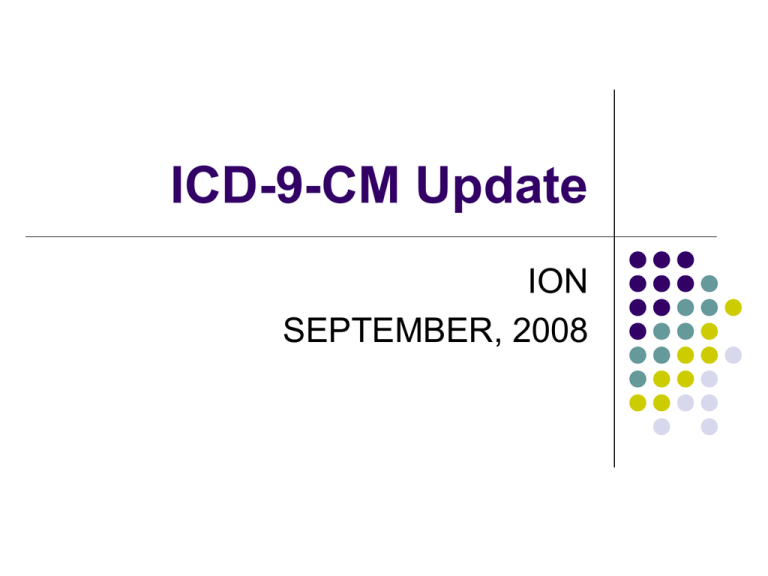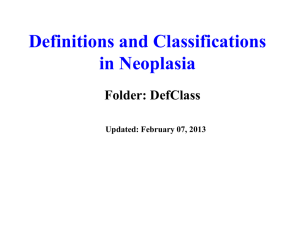
ICD-9-CM Update
ION
SEPTEMBER, 2008
Disclaimer
This presentation is an abbreviated seminar for
practices. Other codes may apply. Please review a
complete list at
Please get a new code book each year to allow for
reference.
This presentation is good for the date of the
presentation only. Typos may be evidenced herein.
It is not coding or legal advice.
All code changes can be found at
http://www.cms.hhs.gov/ICD9ProviderDiagnosticCod
es/
Oncology ICD-9-CM
Introduction (AMA CC)
Chapter 2 of the ICD-9-CM contains the code for most benign and all malignant
neoplasms. Certain benign neoplasms, such as prostatic adenomas, may be
found in the specific body system chapters. To properly code a neoplasm it is
necessary to determine from the record if the neoplasm is benign, in-situ,
malignant, or of uncertain histologic behavior. Malignant is generally the only
one paid for chemo.
If malignant, any secondary (metastatic) sites should also be determined.The
Neoplasm Table in the Alphabetic Index should be referenced first. If the
histological term is documented, that term should be referenced first, rather than
going immediately to the Neoplasm Table, in order to determine which column is
appropriate. For example, if the documentation indicates Adenoma,refer to the
term in the Alphabetic Index to review the entries under this term and the
instructional note to see also neoplasm, by site, benign.
The Table provides the proper code based on the type of neoplasm and the site.
It is important to select the proper column in the Table that corresponds to the
type listed in the record.
ICD-9-CM for Cancer
The Neoplasm Table from AHA(Cont’d)
The tabular should then be referenced to verify that the correct code has been selected and that a more specific site
code does not exist.
If the treatment is directed at the malignancy, designate the malignancy as the principal diagnosis.
When a patient is admitted because of a primary neoplasm with metastasis and treatment is directed
toward the secondary site only, the secondary neoplasm is designated as the principal diagnosis even
though the primary malignancy is still present.
Coding and sequencing of complications associated with the malignant neoplasm or with the therapy
thereof are subject to the following guidelines:
1. When admission/encounter is for management of an anemia associated with the malignancy,
and the treatment is only for anemia, the anemia is designated at the principal diagnosis and is
followed by the appropriate code(s) for the malignancy.
2. When the admission/encounter is for management of an anemia associated with
chemotherapy or radiotherapy and the only treatment is for the anemia, the anemia is
sequenced first followed by the appropriate code(s) for the malignancy.
3. When the admission/encounter is for management of dehydration due to the malignancy or
the therapy, or a combination of both, and only the dehydration is being treated (intravenous
rehydration), the dehydration is sequenced first, followed by the code(s) for the malignancy.
4. When the admission/encounter is for treatment of a complication resulting from a surgical
procedure performed for the treatment of an intestinal malignancy, the complication as the
principal or first-listed diagnosis if treatment is directed at resolving the complication.
Issues in ICD-9-CM
History of
When a primary malignancy has been previously excised or
eradicated from its site and there is no further treatment directed
to that site and there is no evidence of any existing primary
malignancy, a code from category V10, Personal history of
malignant neoplasm, should be used to indicate the former site of
the malignancy. Any mention of extension, invasion, or
metastasis to another site is coded as a secondary malignant
neoplasm to that site. The secondary site may be the principal or
first-listed with the V10 code used as a secondary code.
(Effective 12/01/05)
ICD-9-CM Issues
Admissions/Encounters involving chemotherapy and radiation therapy
When an episode of care involves the surgical removal of a neoplasm, primary or
secondary site, followed by chemotherapy or radiation treatment, the neoplasm code
should be assigned as principal or first-listed diagnosis.
When an episode of inpatient care involves surgical removal of a primary site or
secondary site malignancy followed by adjunct chemotherapy or radiotherapy, code
the malignancy as the principal or first- listed diagnosis, using codes in the 140-198
series or where appropriate in the 200-203 series.
If a patient admission/encounter is solely for the administration of chemotherapy or
radiation therapy code V58.0, Encounter for radiation therapy, or V58.1, Encounter for
chemotherapy, should be the first-listed or principal diagnosis. If a patient receives
both chemotherapy and radiation therapy both codes should be listed, in either order
of sequence
ICD-9-CM Issues
Rule Out Diagnoses (“Rule Out Lung Cancer”)
Never code this as definitive, unless you have clinical evidence.
Codes that describe symptoms and signs, as opposed to
diagnoses, are acceptable for reporting purposes when a related
definitive diagnosis has not been established (confirmed) by the
provider. Chapter 16 of ICD-9-CM, Symptoms, Signs, and Illdefined conditions (codes 780.0 - 799.9) contain many, but not all
codes for symptoms.
ICD-9-CM Guidelines NCHS
Coding and sequencing of complications Coding and sequencing of
complications associated with the malignancies or with the therapy:
1) Anemia associated with malignancy When admission/encounter is for management of an anemia
associated with the malignancy, and the treatment is only for anemia, the appropriate anemia code
(such as code 285.22, Anemia in neoplastic disease) is designated as the principal diagnosis and is
followed by the appropriate code(s) for the malignancy. Code 285.22 may also be used as a secondary
code if the patient suffers from anemia and is being treated for the malignancy. ICD-9-CM Official
Guidelines for Coding and Reporting Effective December 1, 2005 Page 18 of 77
2) Anemia associated with chemotherapy, immunotherapy and radiation therapy When the
admission/encounter is for management of an anemia associated with chemotherapy, immunotherapy
or radiotherapy and the only treatment is for the anemia, the anemia is sequenced first followed by code
E933.1. The appropriate neoplasm code should be assigned as an additional code.
3) Management of dehydration due to the malignancy When the admission/encounter is for
management of dehydration due to the malignancy or the therapy, or a combination of both, and only the
dehydration is being treated (intravenous rehydration), the dehydration is sequenced first, followed by the
code(s) for the malignancy.
4) Treatment of a complication resulting from a surgical procedure When the admission/encounter
is for treatment of a complication resulting from a surgical procedure, designate the complication as the
principal or first-listed diagnosis if treatment is directed at resolving the complication.
ICD-9-CM Guidelines 12/10/05 from NCDVS
Code Sequencing
V58.0, Radiotherapy, and codes from subcategory V58.1x,
Encounter for chemotherapy and immunotherapy for
neoplastic conditions. These codes are to be first listed,
followed by the diagnosis code when a patient’s encounter is
solely to receive radiation therapy or chemotherapy for the
treatment of a neoplasm. Should a patient receive both
chemotherapy and radiation therapy during the same encounter
code V58.0 and V58.1x may be used together on a record with
either one being sequenced first.
V58.1x
Here is the scoop from the ICD-9-CM Maintenance Committee.
V58.11 Encounter for antineoplastic chemotherapy
V58.12 Encounter for immunotherapy for neoplastic condition
“ Immunotherapy also called immune therapy and biologic therapy is a
treatment that stimulates the body’s immune defense system to fight
infection and disease. It is not classified as chemotherapy. Unlike traditional
cytotoxic chemotherapies that attack cancer cells themselves,
immunotherapy is designed to enhance the body’s defenses by mimicking
the way natural substances activate the immune system. These can
stimulate the growth and activity of cancer-killing cells, e.g.interleukin used
in the treatment of malignant melanoma and renal cell carcinoma.”
ICD-9-CM Changes
What drugs are immunotherapy?
This is as follows: "The Food and Drug
Administration has approved several
immunotherapies for use against specific cancer,
including Bacille Calmette-Guerin (BCG),
interferon-alfa (IFN-alfa), interleukin-2 (IL-2), and
other monoclonal antibodies."
V58.1x
Monoclonal Antibodies in Cancer
Rituxan (Rituximab)
Herceptin (Transtuzumab)
Mylotarg (Gemtuzumab ozogamicin)
Campath (Alemtuzumab)
Zevalin (Ibritumomab tiuxetan)
Bexxar (Tositumomab)
Erbitux (Cetuximab)
Avastin (Bevacizumab)
Vectibix (Panitumumab)
Non-Hodgkin’s Lymphoma
The main cell found in lymphoid tissue is the
lymphocyte, an infection-fighting white blood cell, of
which there are two main types, B lymphocytes (B
cells) and T lymphocytes (T cells). B cell lymphomas
account for 85% of the non-Hodgkin's lymphoma
cases in the United States. There is no known cause
for non-Hodgkin's lymphoma but there may be a
relationship between the condition and bacterial or
viral infection
Treatment generally depends on the behavior of the
disease (indolent, aggressive, or very aggressive).
There are thirty (30) subtypes of Non-Hodgkin's
lymphoma.
Source: AHA Coding Clinic
Non-Hodgkin’s Lymphoma
Marginal zone lymphomas (200.3) are slow growing B cell tumors that are categorized
based on whether they occur outside the lymph nodes or within the lymph node. Mucosaassociated lymphoid tissue (MALT) lymphomas for example, are extra-nodal marginal zone
lymphomas that occur in the gastrointestinal tract, eyes, thyroid, salivary glands, lungs, and
skin. Nodal marginal zone B cell lymphomas involve the lymph nodes but are uncommon.
Splenic marginal lymphomas involve the spleen, bone marrow and blood. Treatment for
marginal zone lymphomas depends on type, location and presentation.
Mantle cell lymphoma (200.4) is an aggressive Non-Hodgkin's B cell lymphoma that
accounts for about 6% of all Non-Hodgkin's lymphoma cases in the United States. It is
frequently diagnosed as a stage 4 disease found in the gastrointestinal tract, bone marrow,
and the lymph nodes above and below the diaphragm. The chemotherapeutic approach
using R-CHOP (rituximab, cyclophosphamide, doxorubicin, vincristine and prednisone) is a
common treatment. Mantle cell lymphoma is difficult to treat but combinations of
chemotherapy, biological therapies and other regimens show promise in improving survival.
Source: AHA Coding Clinic
Third Quarter, 2007
Non-Hodgkin’s Lymphoma
Primary central nervous system (CNS) lymphoma (200.5) is found in the brain and
spinal cord. A weakened immune system increases the risk for this aggressive
lymphoma. It is common in patients with acquired immunodeficiency syndrome
(AIDS), history of kidney transplant and other immunocompromised conditions.
Tumors are usually limited to the cranial-spinal axis and to the eye without systemic
involvement. Radiation therapy has been the standard treatment due to the diffuse
nature of this lymphoma.
Large cell lymphomas (200.7) are the most common type of Non-Hodgkin's
lymphoma. They are aggressive and occur in the lymph node and extranodal
sites such as the gastrointestinal tract, testes, thyroid, skin, breast, central
nervous system and bone. Large cell lymphomas comprise 20% to 25% of
childhood lymphomas. High-dose chemotherapy and stem cell/bone marrow
transplant have increased survival rates.
Anaplastic large T cell lymphoma (200.6) and peripheral T cell lymphoma (202.7) are
common T cell lymphomas. Anaplastic large T cell lymphomas can be cutaneous or
systemic. Cutaneous anaplastic large cell lymphomas appear on the skin and grow
slowly. They respond well to radiation and surgery. Chemotherapy is used
occasionally. Systemic anaplastic large cell lymphoma may appear throughout the
body and frequently affect the skin, bone, soft tissue and lung. Although aggressive,
these lymphomas respond to chemotherapy. Peripheral T cell lymphomas represent a
diverse group of lymphomas that are aggressive. They often require salvage
treatment and transplant, yet respond well to treatment.
Cancer ICD-9-CM Codes
10/1/08
199.2 Malignant neoplasm associated with transplant organ
203.02 Multiple myeloma, in relapse
203.12 Plasma cell leukemia, in relapse
203.82 Other immunoproliferative neoplasms, in relapse
204.02 Acute lymphoid leukemia, in relapse
204.12 Chronic lymphoid leukemia, in relapse
204.22 Subacute lymphoid leukemia, in relapse
204.82 Other lymphoid leukemia, in relapse
204.92 Unspecified lymphoid leukemia, in relapse
205.02 Acute myeloid leukemia, in relapse
205.12 Chronic myeloid leukemia, in relapse
205.22 Subacute myeloid leukemia, in relapse
205.32 Myeloid sarcoma, in relapse
205.82 Other myeloid leukemia, in relapse
205.92 Unspecified myeloid leukemia, in relapse
206.02 Acute monocytic leukemia, in relapse
206.12 Chronic monocytic leukemia, in relapse
206.22 Subacute monocytic leukemia, in relapse
206.82 Other monocytic leukemia, in relapse
206.92 Unspecified monocytic leukemia
Cancer ICD-9-CM Codes
10/1/08
207.02 Acute erythremia and erythroleukemia, in relapse
207.12 Chronic erythremia, in relapse
207.22 Megakaryocytic leukemia, in relapse
207.82 Other specified leukemia, in relapse
208.02 Acute leukemia of unspecified cell type, in relapse
208.12 Chronic leukemia of unspecified cell type, in relapse
208.22 Subacute leukemia of unspecified cell type, in relapse
208.82 Other leukemia of unspecified cell type, in relapse
208.92 Unspecified leukemia, in relapse
Cancer ICD-9-CM Codes
10/1/2008
209.00 Malignant carcinoid tumor of the small intestine, unspecified portion
209.01 Malignant carcinoid tumor of the duodenum
209.02 Malignant carcinoid tumor of the jejunum
209.03 Malignant carcinoid tumor of the ileum
209.10 Malignant carcinoid tumor of the large intestine, unspecified portion
209.11 Malignant carcinoid tumor of the appendix
209.12 Malignant carcinoid tumor of the cecum
209.13 Malignant carcinoid tumor of the ascending colon
209.14 Malignant carcinoid tumor of the transverse colon
209.15 Malignant carcinoid tumor of the descending colon
209.16 Malignant carcinoid tumor of the sigmoid colon
209.17 Malignant carcinoid tumor of the rectum
209.20 Malignant carcinoid tumor of unknown primary site
209.21 Malignant carcinoid tumor of the bronchus and lung
209.22 Malignant carcinoid tumor of the thymus
209.23 Malignant carcinoid tumor of the stomach
209.24 Malignant carcinoid tumor of the kidney
209.25 Malignant carcinoid tumor of foregut, not otherwise specified
209.26 Malignant carcinoid tumor of midgut, not otherwise specified
209.27 Malignant carcinoid tumor of hindgut, not otherwise specified
209.29 Malignant carcinoid tumor of other sites
New Cancer ICD-9 Codes
10/1/2008
209.30 Malignant poorly differentiated neuroendocrine carcinoma, any site
238.77 Post-transplant lymphoproliferative disorder (PTLD)
289.84 Heparin-induced thrombocytopenia (HIT)
999.81 Extravasation of vesicant chemotherapy
999.82 Extravasation of other vesicant agent
999.88 Other infusion reaction
999.89 Other transfusion reaction
V07.51 Prophylactic use of selective estrogen receptor modulators (SERMs)
V07.52 Prophylactic use of aromatase inhibitors
V07.59 Prophylactic use of other agents affecting estrogen receptors and estrogen levels
V13.51 Personal history of pathologic fracture
V87.41 Personal history of antineoplastic chemotherapy
V87.42 Personal history of monoclonal drug therapy
V87.49 Personal history of other drug therapy
And, there may be more…
Other ICD-9-CM Changes
Secondary Diabetes Mellitus (249.xx)
New types of headaches (339.xx)
A gaggle of new PAP and anal smear codes
(795.xx-796.xx)
V87.xx for exposure to toxic (and potentially
carcinogenic) substances
Funniest 2009 ICD-9-CM Codes
339.43 Primary Thunderclap Headache
339.82 Headache Associated With Sexual Activity
339.85 Primary Stabbing Headache
372.74 Pingueculitis
611.81 Ptosis of Breast
796.77 Satisfactory Anal Smear, But Lacking
Transformation Zone
Changed Codes of Note
203.00 Multiple myeloma, without mention of having achieved remission
203.10 Plasma cell leukemia, without mention of having achieved remission
203.80 Other immunoproliferative neoplasms, without mention of having achieved
remission
204.00 Acute lymphoid leukemia, without mention of having achieved remission
204.10 Chronic lymphoid leukemia, without mention of having achieved remission
204.20 Subacute lymphoid leukemia, without mention of having achieved remission
204.80 Other lymphoid leukemia, without mention of having achieved remission
204.90 Unspecified lymphoid leukemia, without mention of having achieved remission
205.00 Acute myeloid leukemia, without mention of having achieved remission
205.10 Chronic myeloid leukemia, without mention of having achieved remission
205.20 Subacute myeloid leukemia, without mention of having achieved remission
205.30 Myeloid sarcoma, without mention of having achieved remission
205.80 Other myeloid leukemia, without mention of having achieved remission
205.90 Unspecified myeloid leukemia, without mention of having achieved remission
Changed Codes of Note (2009)
206.00 Acute monocytic leukemia, without mention of having achieved remission
206.10 Chronic monocytic leukemia, without mention of having achieved remission
206.20 Subacute monocytic leukemia, without mention of having achieved remission
206.80 Other monocytic leukemia, without mention of having achieved remission
206.90 Unspecified monocytic leukemia, without mention of having achieved remission
207.00 Acute erythremia and erythroleukemia, without mention of having achieved
remission
207.10 Chronic erythremia, without mention of having achieved remission
207.20 Megakaryocytic leukemia, without mention of having achieved remission
207.80 Other specified leukemia, without mention of having achieved remission
207.20 Megakaryocytic leukemia, without mention of having achieved remission
207.80 Other specified leukemia, without mention of having achieved remission \
208.00 Acute leukemia of unspecified cell type, without mention of having achieved remission
208.10 Chronic leukemia of unspecified cell type, without mention of having achieved remission
208.20 Subacute leukemia of unspecified cell type, without mention of having achieved remission
208.80 Other leukemia of unspecified cell type, without mention of having achieved remission
208.90 Unspecified leukemia, without mention of having achieved remission
V45.71 Acquired absence of breast and nipple
ICD-10-CM
The Department of Health and Human Services (HHS) announced a
long-awaited proposed regulation that would replace the ICD-9-CM
code sets now used to report health care diagnoses and procedures
with greatly expanded ICD-10 code sets, effective October 1, 2011.
In a separate proposed regulation, HHS has proposed adopting the
updated X12 standard, Version 5010, and the National Council for
Prescription Drug Programs standard, Version D.0, for electronic
transactions, such as health care claims. Version 5010 is essential
to use of the ICD-10 codes.
In 2000, under authority provided by the Health Insurance Portability
and Accountability Act of 1996 (HIPAA), the ICD-9-CM code sets
were adopted for use in the administrative transactions by both the
public and private sectors to report diagnoses and inpatient hospital
procedures. Covered entities required to use the ICD-9-CM code
sets include health plans, health care clearinghouses, and health
care providers who transmit any electronic health information in
connection with a transaction for which a standard has been
adopted by HHS.
Overview of ICD-10
International Classification of Diseases and
Related Health Problems, the 10th Edition
Maintained by the World Health Organization
Classifies the causes of disease morbidity and
mortality
Contains diseases, symptoms, etiologies, and
injuries
Official Site:
http://www.who.int/whosis/icd10/
History of ICD
Origin (1893)
WHO (1946)
International List of Causes of Death
International Statistical Institute (ISI)
Morbidity and mortality
Revised every 10 years
ICD-10 (1994)
ICD Revisions
Mortality
ISI
WHO
Mortality
Morbidity
Revision
Implementation in US
1st
1900-1909
2nd
1910-1920
3rd
1921-1929
4th
1930-1938
5th
1939-1948
6th
1949-1957
7th
1958-1967
8th
1968-1978
9th
1979-1998
10th
1999-present
Purpose of ICD-10
WHO:
Statistically oriented classification system for
health census and statistics
To permit the systematic analysis, interpretation
and comparison of mortality and morbidity data
collected in different countries or areas, at
different times
Updates of ICD-10
Must through a local Collaborating Centre
E.g, US: National Center for Health Statistics (NCHS)
Submit to WHO 3 to 6 months before Heads of Centres
annual meeting
Present in Heads of Centres meeting in October
Updates:
Publish no later than 15 months after each Centre Heads
meeting
Latest update available: 1999
(http://www.who.int/whosis/icd10/corr-eng.htm)
Content of ICD-10
Volume 1:
Tabular List
Cause-of-death titles and codes
Classification at 3- and 4-character levels
Volume 2:
Instruction Manual
Description, guidelines, and coding rules
Volume 3:
Alphabetical Index to diseases and nature of injury, external
causes of injury
Table of drugs and chemicals
ICD-10: The Code
Core code:
3 character (1 letter + 2 digits)
A00
Up to 2,600 categories
Mandatory for reporting at the international level
Extended code:
the 4th digit following a decimal point
A00.0
Up to 26,000 categories
Recommended not required by WHO
ICD-10: The Classification
Two types of classification:
Main classification
diagnoses and health status
E11 = Non-insulin dependent diabetes mellitus
Supplementary classification
generally outside the formal diagnoses but related
to health care
Z83.3 = Family history of diabetes mellitus
ICD-10 Hierarchy for Classification
9,275 codes used in US
ftp://ftp.cdc.gov/pub/Health_Statistics/NCHS/Publications/ICD10/
3 level hierarchy
Level 1: the 21 chapters
21 categories
Level 2: the 1st – 3rd characters (A00)
1643 categories
Level 3: the 1st – 4th characters (A00.0)
7611 categories
Site for browsing the hierarchy and searching diseases:
http://www.med-ia.ch/bolinosmed/codifications/icd10/
Most Important Coding Rules of
ICD-10
1— Highest Level of Specificity
2— Daggers (†) and asterisks (*) are coded
together, daggers first
3— Principal disease: one disease of major
medical cost
1. Highest Level of Specificity
As specific as possible
Patient:
Type 2 diabetes mellitus with renal complications
Code:
E11.2 = Type 2 diabetes mellitus with renal
complications
Not E11 = Type 2 diabetes mellitus
2. Dagger and Asterisk
For a disease encoded by two codes
Dagger represents etiological aspects.
Asterisk refers to anatomical location
Example:
For Renal tuberculosis:
A18.1† urogenital tuberculosis
N29.1* infectious disease of kidney and
ureter classified elsewhere
. .
Differences between ICD-9 &
ICD-10 : Breast Cancer (Partial List)
174 malig neo female breast
1740 malig neo nipple
1741 mal neo breast-central
1742 mal neo breast up-inner
1743 mal neo breast low-inner
1744 mal neo breast up-outer
1745 mal neo breast low-outer
1746 mal neo breast-axillary
1748 malign neopl breast nec
1749 malign neopl breast nos
175 malig neo male breast
1750 mal neo male nipple
1759 mal neo male breast nec
C50011
C50012
C50019
C50021
C50022
C50029
C50111
C50112
C50119
C50121
C50122
C50129
C50211
C50212
C50219
breast
C50221
C50222
C50229
breast
C50311
C50312
C50319
breast
C50321
C50322
C50329
breast
C50411
C50412
C50419
breast
C50421
C50422
C50429
breast
C50511
C50512
Malignant neoplasm of nipple and areola, right female breast
Malignant neoplasm of nipple and areola, left female breast
Malignant neoplasm of nipple and areola, unspecified female breast
Malignant neoplasm of nipple and areola, right male breast
Malignant neoplasm of nipple and areola, left male breast
Malignant neoplasm of nipple and areola, unspecified male breast
Malignant neoplasm of central portion of right female breast
Malignant neoplasm of central portion of left female breast
Malignant neoplasm of central portion of unspecified female breast
Malignant neoplasm of central portion of right male breast
Malignant neoplasm of central portion of left male breast
Malignant neoplasm of central portion of unspecified male breast
Malignant neoplasm of upper-inner quadrant of right female breast
Malignant neoplasm of upper-inner quadrant of left female breast
Malignant neoplasm of upper-inner quadrant of unspecified female
Malignant neoplasm of upper-inner quadrant of right male breast
Malignant neoplasm of upper-inner quadrant of left male breast
Malignant neoplasm of upper-inner quadrant of unspecified male
Malignant neoplasm of lower-inner quadrant of right female breast
Malignant neoplasm of lower-inner quadrant of left female breast
Malignant neoplasm of lower-inner quadrant of unspecified female
Malignant neoplasm of lower-inner quadrant of right male breast
Malignant neoplasm of lower-inner quadrant of left male breast
Malignant neoplasm of lower-inner quadrant of unspecified male
Malignant neoplasm of upper-outer quadrant of right female breast
Malignant neoplasm of upper-outer quadrant of left female breast
Malignant neoplasm of upper-outer quadrant of unspecified female
Malignant neoplasm of upper-outer quadrant of right male breast
Malignant neoplasm of upper-outer quadrant of left male breast
Malignant neoplasm of upper-outer quadrant of unspecified male
Malignant neoplasm of lower-outer quadrant of right female breast
Malignant neoplasm of lower-outer quadrant of left female breast
References
World Health Organization (WHO)
http://www.who.int
WHO statistical information
http://www.who.int/whosis/icd10/
Centers for Disease Control (CDC) National
Center for Health Statistics (NCHS)
http://www.cdc.gov/nchs
http://www.cdc.gov/nchs/about/otheract/icd9/abticd10.htm
http://www.cdc.gov/nchs/about/major/dvs/icd10des.htm
Get Ready for October 1
Check codes against the full list of codes that you
use and make sure that nurses and doctors are
updated on the coding possibilities.
Spot check your PM system to make sure additions
and changes are in your billing and EMR systems.
Update Superbill or EMR Problem List as necessary.
Educate billers and coders.








